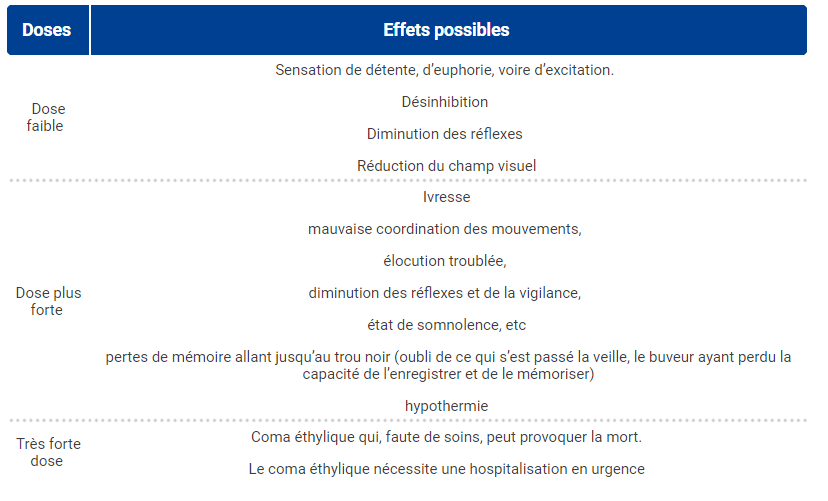[Article updated on 19/09/2023]
Alcohol, frequently consumed and highly appreciated, is not without consequences on the body. From occasional consumption to dependence, alcohol is present among the majority of French people since 87% of them say they consume it at least once a year.
23.6% of people between 18 and 75 years old exceed the daily consumption benchmarks (2 glasses per day).
These figures therefore reveal the omnipresence of alcohol in our daily lives.
But what are the consequences on our body?
The brain
The brain is one of the first victims of overconsumption of alcohol.
Alcohol acts like a narcotic on the brain. Initially it creates a state of euphoria then quickly leads to a state of drowsiness and numbness. In the long term, and with an average daily consumption of six glasses per day, certain cells will gradually disappear, this is what we call “loss of brain tissue”. This loss causes the brain to shrink.
More specifically, alcohol acts on particular areas of the brain:
- Frontal cortex : This area is the seat of higher cognitive functions such as reasoning, executive functions, language, working memory.
This cortex, altered by chronic alcohol consumption, thus induces a decline in intellectual abilities and disinhibition. - Seahorse : Plays a major role in memory and spatial navigation. Thus, the latter is directly affected whether in a state of total intoxication (amnesia) or in the long term (progressive loss of memory and difficulty remembering certain things).
- The cerebellum : It controls motor skills and plays a role in certain cognitive functions. It is common to observe a lack of balance and coordination in a person who has consumed a large quantity of alcohol. This imbalance is a factor favoring accidents, particularly on public roads.
- The brainstem : plays an essential role in primary functions such as breathing or heartbeat. When overconsumption of alcohol, it is possible to observe a loss of consciousness, inducing anesthesia in this region. This results in a risk of coma or even death.
In some cases we can observe the appearance of Korsakoff syndrome, which represents a neurological disorder originating from a vitamin B1 deficiency (often correlated with chronic alcoholism).
A close link between depression and chronic alcoholism has now been proven, and the risk of dependence increases if mental health is impaired and vulnerable.
Indeed, alcohol acts on the release of dopamine (neuromediator of pleasure) and therefore can induce a state of dependence.
Alcohol dependence currently represents 10% of adult consumers in France. (Inserm data)
Furthermore, it is undeniable that even so-called “light” alcohol consumption has a direct impact on certain areas of the brain. It goes without saying that chronic overconsumption has a greater impact and can cause irreversible damage.

Consequences on the liver
When ingesting alcohol, ethanol is directly absorbed by the digestive tract. The majority is taken to the liver to be oxidized. Ethanol is transformed into acetaldehyde, a very toxic metabolite.
From a hepatic point of view, the first consequence is steatosis, that is to say an accumulation of fat in the liver cells.
If consumption persists, inflammation sets in, even leading to necrosis (death) of liver cells. We thus observe fibrosis, in other words, a process of scar tissue formation.
The main consequence of fibrosis is cirrhosis, it corresponds to a modification of the liver tissue which becomes hard.
Cirrhosis is a pathology frequently encountered in alcoholics; it can cause jaundice or, more seriously, liver cancer.
Alcohol toxicity can induce the appearance of acute alcoholic hepatitis which leads to sudden and irreversible cell death. The risk of mortality is increased, so total abstinence from alcohol is imperative.
Cardiovascular illnesses
The impact of alcohol on cardiovascular diseases is controversial. It is true that some have long advocated the beneficial effects of moderate consumption, while others discriminate against it by pointing out the deleterious effects on cardiovascular health.
A meta analysis of Ronksley in British medical journal studies the impact of chronic alcohol consumption on cardiovascular diseases. To do this, it compares a group of individuals with zero alcohol consumption and a group of individuals consuming at most 4.5 glasses per day. The results show a reduced risk of cardiovascular disease among people consuming an average of 1.1 glasses of alcohol per day.
Thus “small chronic drinkers” would have a 14 to 25% less chance than abstinent people of developing cardiovascular disease.
Alcohol could therefore have a protective role. This protective effect can be explained by an increase in HDL levels in the event of alcohol consumption. HDL cholesterol is what is more commonly called “good cholesterol”. It helps prevent the accumulation of fatty substances along the walls of blood vessels, and therefore avoids their obstructions. In addition, HDL allows the elimination of excess cholesterol in the organs.
However, other studies implicate alcohol as a factor favoring the occurrence of cardiovascular diseases.
In excess and in the long term, alcohol can impact arterial stiffness leading to a reduction in dilation or contraction capacities which usually fluctuate depending on blood pressure. There is thus a risk of ischemic or hemorrhagic stroke (cerebrovascular accident).
In certain cases, an increase in heart volume is sometimes observed in heavy consumers. This enlargement weakens the circulation of blood within the heart, this is what we call dilated cardiomyopathy.
In order to best preserve your vascular health, alcohol consumption should be limited and occasional.

Cancer
Alcohol is considered carcinogenic since studies show that it is responsible for 11% of cancer cases in men and 4.5% in women.
Chronic alcohol consumption notably has an impact on the development of certain cancers: aerodigestive tract, esophagus, stomach, liver, colon, and breast.
Acetaldehyde, a chemical compound resulting from the transformation of alcohol during digestion processes, is toxic when its concentration becomes too high. It is partly responsible for the occurrence of cancers, particularly of the liver and breast.
When alcohol consumption is correlated with tobacco consumption, then the health effects are catastrophic. The risk of developing cancer of the upper aerodigestive tract is increased since the effects between tobacco and alcohol are synergistic.
It is obvious that there is a lack of knowledge about the risks of overconsumption of alcohol. Public health now makes a point of informing the population through prevention messages and campaigns. However, is this really enough?
In 2013, the turnover of the alcohol sector was close to 22 million euros. Beyond an economic market, alcohol represents a true French tradition, notably thanks to the wine estate.
Between economy and tradition, alcohol is an omnipresent symbol during social and significant events in our lives. Alcohol is a social, cultural and harmful factor.
Prevention and education related to alcohol consumption must be done systematically from an early age.
So, it is not a question of banishing alcohol from our eating habits, but of changing our consumption.
